European cooperation: what is it?
In 1951, six European states (West Germany, France, Italy, Belgium, Luxembourg and the Netherlands) signed their first treaty for a coal and steel union. They called it the European Coal and Steel Community (ECSCG).
It didn’t take long to persuade policy makers to combine forces in the field of nuclear energy, in addition to coal and steel, as this was an endeavour that no single post-war European country could have undertaken alone. So the European Atomic Energy Community Treaty (EURATOM) was signed on 25 March 1957, along with the Treaty of Rome. It was a far greater challenge convincing all the EECG members that they would likewise have strength in numbers in other science and technology fields. France was already pushing this idea in the 1950s, but it did not catch on.
“There has always been nationalism in anything technical.” (Peter Kirstein, British computer scientist)
Continue reading at SCIENCEA need to join forces
From 1958 to 1960 US physicist Nelson BlachmanP travelled for the ONR London all over Europe in order to exchange scientific information with Europeans in the field of electronics. He reports that practically every country in Europe has a digital computer now, but compared to the US only few people are involved in this endeavour.
“Many European machines were built by a group of no more than five men over the course of one to three years. However, commercial machines are built by large teams just as in the US. Other significant differences are found in the order codes for these machines, which often include references to a fixed store containing useful subroutines that, in effect, expand the repertoire of operations.”
Nelson M. Blachman, 1961
What was the problem to solve:
In 1967, while searching for a legal framework to expand coordination to intensive industry research initiatives and non-EEC members, the Euratom Treaty was used as a blueprint for expanding the agenda also to data-processing and data exchange.
Computer power was needed in every European country in order to analyse the huge amount of data generated by particle physicists in laboratory experiments. Yet, big data analysis was not a priority of politicians at that time. Pierre AigrainP, a physicist and Secretary of Research at the French Academy of Sciences, at a dinner talk at CERNG in 1973, postulated with hindsight that one reason for this might be that only the French (Machines Bull) and the Germans (Siemens, AEG-Telefunken and Nixdorf) had a stake in the computer market. The Netherlands at least had Philips – a firm which appeared capable of entering the market – and Italy had Olivetti, a company that was mainly active in peripheral equipment. Belgium had nothing except steel.
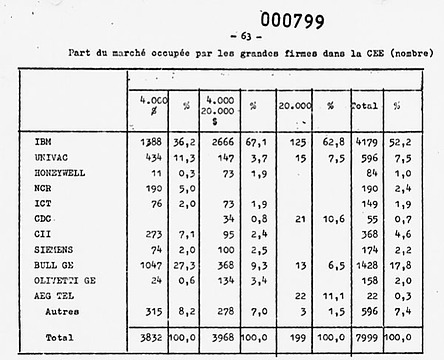
“The Belgians were ready to pay their share of the development cost for a project which would be carried out entirely by companies which are not on Belgian soil because they felt it was so important for Europe as a whole. I heard one of the Belgian members of the Committee say ‘Even if we never make computers, these things will use iron and we make lots of iron’.”
Source: Pierre Aigrain, Computing and science research in Europe, Computer Physics Communications 3, Supplement, 1, p. 166-173, North-Holland Publishing Company, 1972
Business had networking needs too
Besides particle physicists, banks in Switzerland and the UK also felt the need to use computers and to exchange data. Their interest in data communications over leased lines led to the foundation of SWIFTG in 1972. Furthermore, the airline industry, which established its airline reservation system SITAG in 1966, had soon interconnected ten European Airlines (Aer Lingus, Alitalia, BOAC and BEA – which merged to become BA – KLM, Swiss, Iberia, Lufthansa, SAS and Air France).
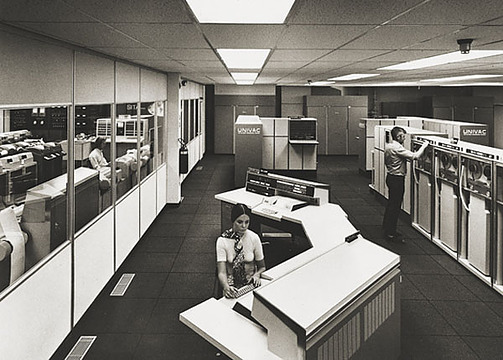
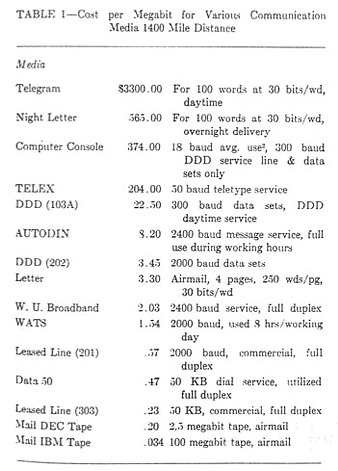
Communications media costs, 1971.
The whole world was searching for fast, low-cost digital communication alternatives, in view of the fact that sending a Telex in the US over a distance of 1400 miles cost 204 USD per megabit in 1971. If a company could make use of leased lines that cost was reduced to 0.57 USD.
“To be a useful utility, it was felt that communications costs for the network should be less that 25% of the computing costs of the systems connected through the network. This is in contrast to the rising costs of remote access communications which often cost as much as the computing equipment.
Barry Wessler, was involved in the development of the ARPANET from 1967 onward. Before he joined the Department of Defence, he worked for Visual Equipment Corporation in the graphic systems area doing both hardware and software design. He was also in Project MAC while at Massachusetts Institute of Technology (MIT).
If we examine why communications usually cost so much we find that it is not the communications channel per se, but our inefficient use of them, the switching costs, or the operating cost. To obtain a perspective on the price we commonly pay for communications let us evaluate a few methods. As an example, let us use a distance of 1400 miles since that is the average distance between pairs of nodes in the projected ARPA Network. A useful measure of communications cost is the cost to move one million bits of information, cents/megabit. In the table at left this is computed for each media. It is assumed for leased equipment and data set rental that the usage is eight hours per working day.“
Interestingly, the program chair and conference organiser Fran Balint mentioned that the cost per node for communications in the ARPA system is $59,000.
”I quickly counted up the number of nodes and it is something like 19 or 20. I multiplied this together and it comes out to $1.2 million for communications. Has anybody told AT&T? I can see the problems coming about similar to those problems which happened in New York City where the data people degraded the voice system.”
Fran Balint was chief of the management and planning branch of the computer division of the environmental science services administration. At the time he was Vice-Chairman of SIGCOSIM
Source: SIGCSIM Newsletter, Issue 8, ACM, 1971.
http://dl.acm.org/citation.cfm?id=1147453&CFID=355877582&CFTOKEN=19677577\
SITA’s first computer message switching computer was installed in 1966, and their first high level network implemented in 1969. It was used for sending information about lost luggage, passenger reservation and flight servicing back and forth between centres.
In the early 1970s already 175 international airlines were part of this particular network. Notes with an average of 200 characters per message were sent over leased lines to other switching centres in Amsterdam, Brussels, Frankfurt, Hong Kong, London, Madrid, Paris, Rome and New York. Travel agents needed even fewer characters to fulfil their communication needs.
“A typical Class A inquiry is 18 characters long and the response from the airline’s central reservations computer is 100 characters.”
Phil Hirsch, Communications Editor at the U.S. magazine Datamation, 1974.
The world was searching for fast and low cost digital communication alternatives, in 1971. Especially if one considers that sending a Telex over a distance of 1400 miles in the US cost 204 Dollar per Megabit in 1971. Using leased lines instead reduced the cost to US $ 0.57
Meanwhile at the European Commission
By 1967, Brussels had realised it needed to invest in modern techniques of collecting and distributing documentation in order to foster “research and innovation”. One political argument was that the US was already investing 100 million dollars per year in this field. (Source: Historical Archive of the European Commission, CEAB 1967
One should be careful to interpret this development against the backdrop of ARPANET. Even in the US, it was not until 1967 that Robert Taylor entered the office of Charles HerzfeldP, ARPA’s director, to ask him to sign a check that would finance a feasibility study on ARPANETG. Legend has it that Taylor convinced his boss in a mere twenty minutes. In Europe it would take years before the first contract to build an experimental pan-European research network was signed.
Taylor cuts the story short. Charles Herzfeld and he had already met, on the recommendation firstly of JCR Licklider and then John von Neumann, who were the big stars in computing at the time. He had also seen the RAND Tablet, a man-machine graphical communication device, which was developed for ARPA in 1964. So Herzfeld was quite well prepared when Robert Taylor entered his office in 1967.
Playing the national card
Politicians in Brussels made up their mind finally that in the field of information exchange and administration, computers were beneficial. It was fairly clear that the only computer industry that might have a chance of blowing any influential breeze across the Atlantic towards IBM, the leading company at that time, was based in Britain. Already in 1959, the UK had begun a series of mergers that would culminate in a single British computer company, completed in 1968 with the launch of ICLG.
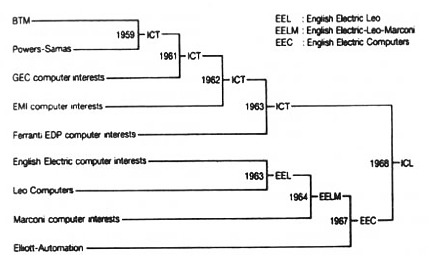
Great Britain’s push towards EC membership
Prime Minister Harold Wilson identified the UK’s strength in technology and started a programme to unite the British computer market through a merger. In 1968, this undertaking was completed, and such fine-sounding names as Ferranti, Elliott Brothers, English Electric and Leo Computers all disappeared into the archives.
The new name on the table was ICL, International Computers Limited, which had thus become the largest computer manufacturer outside the USA. Though size doesn’t mean everything, even after Wilson’s government pledged to assist with an amount of 25-30 million pounds to build the ICL computer line. It was probably seen as a good investment, touted as an alternative to the IBM machines for the European market. Nevertheless, at the end of the day, the merger did not gain Wilson any leverage to enter the European Economic Community (EEC), due to de Gaulle’s scepticism towards the British. He was not at all in favour of opening the EEC’s doors to the UK, having blocked their membership twice, in 1962 and 1967. De Gaulle wanted to expand Europe east, not west.
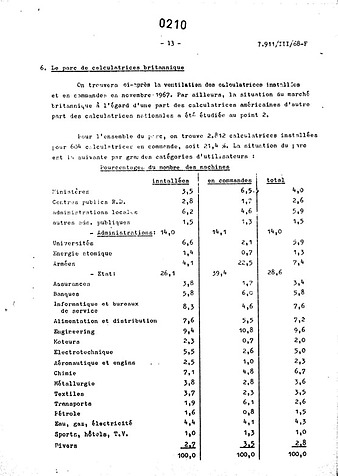
The Council and the Commission, 1967
427. The Council resumed its discussion of the United Kingdom’s application at its session of 18 and 19 December 1967, at the end of which it published the following statement:
Considering the objectives laid down in the Preamble to the Treaty of Rome, and considering the tasks falling to the Member States pursuant to Article 5, which provides that they shall abstain from any measures which could jeopardise the attainment of the objectives of the Treaty, the Council of the European Communities, meeting at Brussels on 19 December, noted that no Member State has raised any fundamental objection to the enlargement of the Communities. When noting this fact, the Council assumed that the new member states would fully accept the Treaties and decisions adopted by the Community.
One Member State, however, expressed the opinion that this enlargement would profoundly alter the nature of the Communities, and the methods of administering them.
Five Member States agreed with the Commission’s point of view. They expressed their desire for the immediate opening of negotiations for the accession of Great Britain, Denmark, Ireland and Norway, so that these negotiations might be undertaken in parallel with the re-establishment of Great Britain’s economic situation.
One Member State considered, that the re-establishment of the British economy must be completed before Great Britain’s request can be reconsidered.
For this reason, there was no agreement in the Council at this stage on the next step to be taken. The President of the Council was instructed to inform the countries in question accordingly.” (Source: First General Report on the Activities of the Communities 1967, published February 1968)”
428. The Commission published the following statement on 20 December 1967:
“The Commission deeply regrets the Council’s failure to reach agreement on what steps should be taken to deal with the applications for membership of the Communities made by a number of European countries, in particular the United Kingdom.
Whatever difficulties of substance may have arisen, the Commission still believes that the countries concerned must be given a hearing and that the Communities should negotiate with them in order to ascertain whether solutions acceptable to all can be found.”
Source: ECSC, EEC, EURATOM,Commissin, First General Report on the Activities of the Communities, Chapter VI, External Relations, the enlargement of the Community, 1967
It wasn’t just de Gaulle’s ideas on what Europe should become that mattered: other voices feared ICL’s size and strength. By 1967, ICL was the largest computer manufacturer outside of the USA, employing 34,000 staff. The UK government promised a cash infusion of 25-30 million pounds to build a new computer series.
De Gaulle, of course, wasn’t impressed at all. So he maintained an “empty chair policy”, vetoing the UK’s second membership application in December 1967. The only difference from 1962 was that this time his colleagues did not sit still. As a diplomatic warning shot, the Italian and Dutch delegates failed to appear at meetings.
Ironically, this especially affected the science committee PRESTG, who had a proposal pending. After three years of discussion, Maréchal was waiting for an answer from the Member states on which research projects would finally see daylight. Thanks to the empty chair policy, the final outcome was that PREST had to seek a new head: Pierre Aigrain succeeded André Maréchal. Furthermore, the idea of building an experimental pan-European computer network was postponed.
Europe has a management problem to solve, OECD Report, 1968
Continue reading at POLITICSFrance: Same idea, different nations
Like Britain, France also announced it was fomenting a computer industry in 1965, with its “Plan Calcul”. Contrary to the UK, France’s starting point was certainly different. Bull, their former champion on the computer market, had been sold to the US company General Electric due to bankruptcy in 1964.
However, Plan CalculG was seen as a push to support the concept of French independence in technology, and probably also as a business case, which would flourish in time. After all, every European nation was willing to spend a fortune on these machines. Moreover, there was an ongoing quarrel between the US and France over an import embargo on the delivery of American mainframe computers. This might have helped convince the Élysée Palace in Paris to make Plan Calcul a high priority. Though not everybody would agree with this.
In an article published in 1967, science writer John Walsh characterised the problem of French computer companies as being too small, badly managed and spending too little on research. Robert Galley must have known that. It was he who set the scene to merge the remaining parts of the French computer industry, namely Société d’électronique et d’automatisme (SEA) and Compagnie européenne d’automatisme électronique (CAE).
Like the British plan, Plan Calcul also launched a new name onto the computer market: Compagnie Internationale pour l’Informatique (CIIG).
“The budget for Plan Calcul has been set at 104 million francs ($21 million) for this year and a total of 450 million francs ($90 million) by 1970. Most observers think that government funds going to the programme could far exceed these figures. Plan Calcul is designed to mesh with the present Fifth Plan for social and economic development (1966-1970), but it is interesting to note that Plan Calcul was not called for in the Fifth Plan, which was formulated in 1964 and 1965. Plan Calcul was presumably an urgent afterthought, with the French, perhaps prompted more by the events of the past two years.”
Source: John Walsh, France: First the Bomb, Then the ‘Plan Calcul’, Science, Vol. 156, 12 May 1967.
And West Germany?
According to Pierre Aigrain, the West German Five Year Plan in this field came late. It covered the period from 1970 to 1975. It might be worth recalling that after World War II, West Germany’s high-tech activities were restricted in the field of chemicals as well as in the aerospace industry. Therefore, in order to enter high technology research fields and the space race, cooperation was much more a necessity for West Germany than for other European countries.
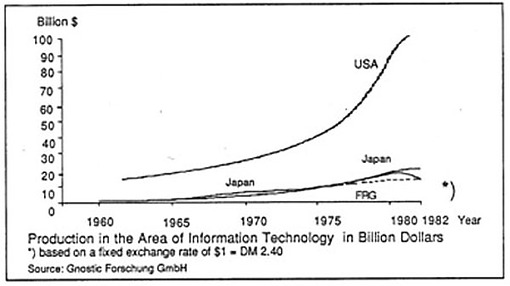
“By tying its space efforts to West European programs, Germany could prove that its ambitions in space were entirely peaceful and cooperative.”
Source: Wayne Sandholtz, High-Tech Europe, 1992
Interestingly, it was the West German government which did not agree with France’s and Britain’s notion that procurement could constitute a political action for boosting science and technology. At least that is Pierre Aigrain’s opinion, as he concluded in his speech, “Computing and science research in Europe”, in 1973:
“Not because they think it’s unethical, but because they claim that if you give grants to develop a better product you may achieve competitiveness on the world market. If you only give preference for public buying, you are not giving anything unless the product is not competitive to start with. Well, this is German reasoning. On the other hand, for example, the Dutch think quite opposite on the problem, and, quite obviously, also the British since preferential buying is what they are doing. We in France have come to the conclusion that since we did not know we would try both at once, which is a little what we are doing, but you see that this is a difficult problem.”